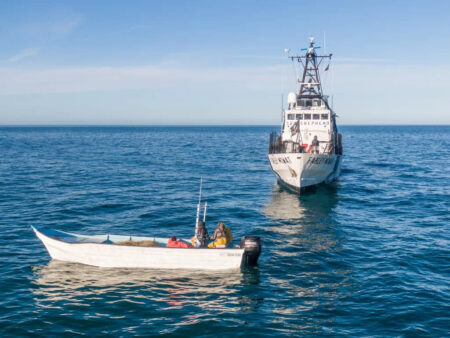 (Part I) San Felipe, Baja California, Mexico. The long-running global struggle to prevent extinction of the world’s most endangered marine mammal claimed its first human life here on Jan. 2, in the conflict between illegal fishing and conservation of the vaquita porpoise.
(Part I) San Felipe, Baja California, Mexico. The long-running global struggle to prevent extinction of the world’s most endangered marine mammal claimed its first human life here on Jan. 2, in the conflict between illegal fishing and conservation of the vaquita porpoise.
Fisherman Mario Garcia Toledo, 56, died after suffering massive injuries when his skiff collided with a vessel of the international marine-life watchdog Sea Shepherd while the latter was combing clandestine nets from the waters of the no-catch zone in the Vaquita Refuge of the Upper Golf of California.
The tragedy, under investigation by the Mexican Navy, threw into sharp relief the demand for measures to quell the piracy and lawlessness that have reduced the vaquita (Phocoena sinus) population from 567 in 1997 to no more than 20 today.
The chart for that is no simple formula, requiring not only the fresh tack being taken by the administration of Andres Manuel Lopez Obrador, but also a change in strategy by non-governmental organizations.
To obtain buy-in from the region’s desperate fishing communities, enabling them to become a bulwark against organized crime, government must get on board the effort to effectively enforce internationally mandated marine conservation measures.
At the same time, organized civil society must nurture cooperation between authorities and community members for mutually acceptable catch techniques or alternative income opportunities in the realm of fair trade.
While shrimping traditionally has been the economic strong suit in the Upper Gulf of California, the fishery has been plagued by the black market for totoaba (Totoaba macdonaldi), a finfish prized for its swim-bladder soup by elite consumers in China. The totoaba’s maw is literally worth its weight in gold, with one gram selling for more than $40 at retail.
It is being caught in the same gillnets conventionally used for shrimp, which also snare and suffocate the vaquita. Both totoaba and vaquita are endemic forms of marine life that measure a little less than two meters long. They exist nowhere except in the Upper Gulf, or Alto Golfo. The need to protect them led to a ban on gillnets several seasons ago.
After 25 years of unsuccessful attempts to halt the trade in the now critically endangered totoaba and the bycatch of the even more critically endangered vaquita porpoise, the main outcomes of the campaign to save the species are: the loss of local fishing income, the rise of corruption, and foreign sanctions crushing Mexico’s all-important seafood industry.
The vaquita’s population implosion provoked the extension this past March 5, of a 2018 U.S. trade embargo on the importation of Mexican shrimp, fish, and other seafood. A committee from the Convention on International Trade in Endangered Species (CITES) also is considering commercial sanctions against Mexico for failing to halt the illegal exportation of any fish captured in gillnets.
Under economic pressure, the relatively new — and decidedly different — Lopez Obrador administration employed an unprecedented tactic. It turned to intelligence gathering, investigation and high-level analysis of results.
Not surprisingly, the clues to the money trail came from a non-governmental organization, this one being Earth League International, whose Wildlife Crime Division “worked tirelessly to gather the intelligence needed by authorities.”
The grassroots sleuthing operation prepared and submitted a “Confidential Intelligence Brief” to law enforcement authorities in Mexico, China and the United States, containing the non-redacted data gathered regarding the key players, their networks and enablers, and the complete modus operandi of the traffickers and traders. The brief included concrete evidence of illegal activity uncovered during the investigation, and hundreds of photos and hours of relevant undercover footage.
The outcome was the November 2020 landmark arrest of six fishing concession owners, alleged poachers and traffickers, on charges of leading organized crime against health and the environment. This is the first time that Mexican prosecutors have made accusations linking clandestine fishing conspirators with a drug cartel whose transport route they are thought to utilize.
Evidence resulted in four of the suspects going to jail in Hermosillo, Sonora: Sunshine R.; Enrique M.; Juan Luis G., known as “La Yegua”; and former Federal Environmental Prosecutor Enrique G. (“El Kiki”), injured in March 2019 while being pursued for a totoaba in his possession. Luis A. and his wife Carmen were released.
Contrary to some expectations, however, the shakeup did not increase public security. By the time López Obrador arrived in the Baja California state capital of Mexicali in December to showcase the joint law enforcement venture, he had to concede, “We intended to go to San Felipe, but I didn’t want to now because I want progress on the integrated program. We will visit that area when the time is ripe.”
About 200 fishing villagers mobbed the federal installations of the coast guard after its members brought ashore the wounded Garcia Toledo, who later died, and his injured fishing companion. Both were rescued by Sea Shepherd crew. Convinced the environmentalists of Sea Shepherd are a threat to their livelihoods, the protesters stoned people and buildings, set fires to cars and boats, and triggered a call for air, land and sea support, the Navy Secretariat reported.
The aggression, which originated with projectiles hurled at the Sea Shepherd from a number of fishing skiffs, was only the latest in a pattern of escalating violence since a 2019 incident in which a Sea Shepherd vessel was illegally boarded and set fire.
The world is waiting to see if AMLO’s next visit to Mexicali, planned for Jan. 15, will provide more concrete identification of means to revert illegal fishing and repair damage to socioeconomic systems allegedly entwined with the Cartel del Mar.
(Part II will examine the official policies and non-governmental organizations’ new role in the conflict.)
Talli Nauman is the director of Journalism to Raise Environmental Awareness and a long-time analyst and columnist for the Americas Program.



